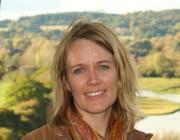Citation:
Abstract:
Understanding the influence of within-pixel land cover heterogeneity is essential for the extrapolation of measured and modeled CO2 fluxes from the canopy to regional scales using remote sensing. Airborne light detection and ranging (lidar) was used to estimate spatial and temporal variations of gross primary production (GPP) across a jack pine chronosequence of four sites in Saskatchewan, Canada for comparison with the Moderate Resolution Imaging Spectroradiometer (MODIS) GPP product. This study utilizes high resolution canopy structural information obtained from airborne lidar to bridge gaps in spatial representation between plot, eddy covariance (EC), and MODIS estimates of vegetation GPP. First we investigate linkages between canopy structure obtained from measurements and light response curves at a jack pine chronosequence during the growing season of 2004. Second, we use the measured canopy height and foliage cover inputs to create a structure-based GPP model (GPPLandsberg) which was tested in 2005. The GPP model is then run using lidar data (GPPLidar) and compared with eight-day cumulative MODIS GPP (GPPMODIS) and EC observations (GPPEC). Finally, we apply the lidar GPP model at spatial resolutions of 1 m to 1000 m to examine the influence of within-pixel heterogeneity and scaling (or pixel aggregation) on GPPLidar. When compared over eight-day cumulative periods throughout the 2005 growing season, the standard deviation of differences between GPPlidar and GPPMODIS were less than differences between either of them and GPPEC at all sites. As might be expected, the differences between pixel aggregated GPP estimates are most pronounced at sites with the highest levels of spatial canopy heterogeneity. The results of this study demonstrate one method for using lidar to scale between eddy covariance flux towers and coarse resolution remote sensing pixels using a structure-based Landsberg light curve model.


